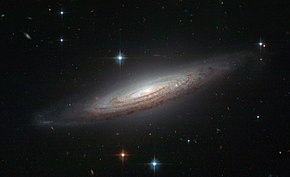Loading AI tools
Galaxy in the constellation Triangulum From Wikipedia, the free encyclopedia
NGC 634 is a spiral galaxy, lying at a distance of 217.1 megalight-years[3] away from the Milky Way in the northern constellation of Triangulum. This object was discovered on 26 October 1876 by French astronomer Édouard Stephan.[7][8] It is inclined by an angle of 82.4° to the line of sight from the Earth, and thus is being viewed nearly edge on.[5]
| NGC 634 | |
|---|---|
 Picture created from images taken with the Wide Field Channel of Hubble's Advanced Camera for Surveys | |
| Observation data (J2000 epoch) | |
| Constellation | Triangulum |
| Right ascension | 01h 38m 18.679s[1] |
| Declination | +35° 21′ 53.47″[1] |
| Redshift | 0.016417[2] |
| Heliocentric radial velocity | 4,925 km/s[3] |
| Distance | 217.1 Mly (66.55 Mpc)[3] |
| Apparent magnitude (V) | 14.0 |
| Characteristics | |
| Type | Sa[4] |
| Apparent size (V) | 2′.04 × 0′.55[5] |
| Other designations | |
| MCG+06-04-048, UGC 1164,[6] PGC 6059 | |
Supernova SN 2006Q was reported 2.5″ east and 1.0″ north of the galactic core in NGC 634, January 24, 2006. This was most likely a type II supernova[5] and reached magnitude 18.74.[9] Another supernova explosion was reported near the galaxy on January 2, 2008. It was positioned 16.6 arcseconds west and 20.2 arcseconds north of the Galactic Center and was designated SN 2008A. This event reached a peak magnitude of 16.7 on January 3,[10] and was determined to be a type Iax supernova.[5]
Seamless Wikipedia browsing. On steroids.
Every time you click a link to Wikipedia, Wiktionary or Wikiquote in your browser's search results, it will show the modern Wikiwand interface.
Wikiwand extension is a five stars, simple, with minimum permission required to keep your browsing private, safe and transparent.